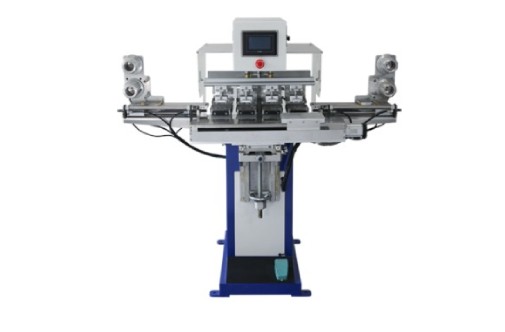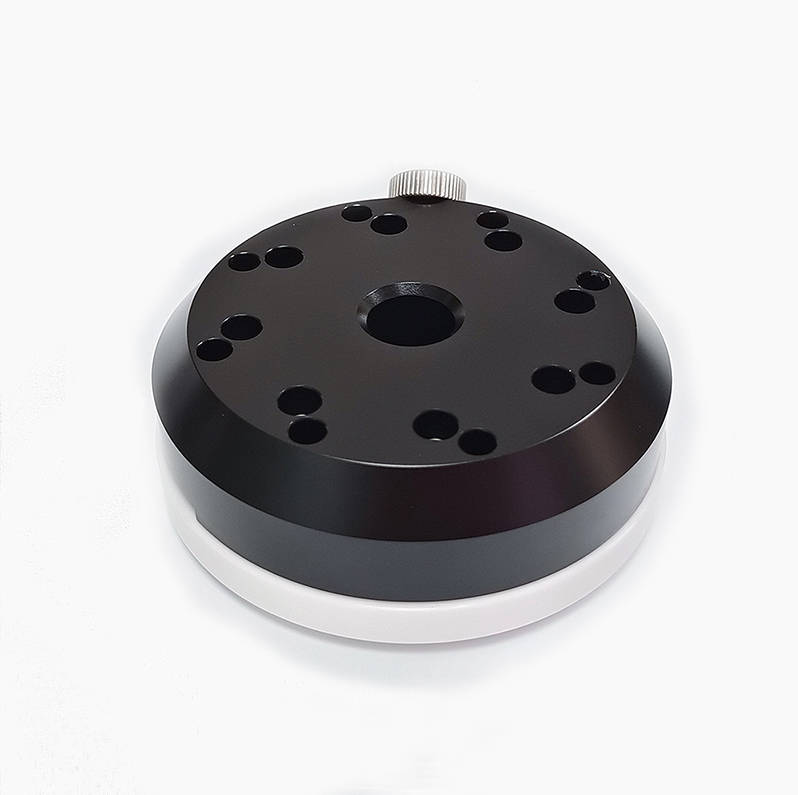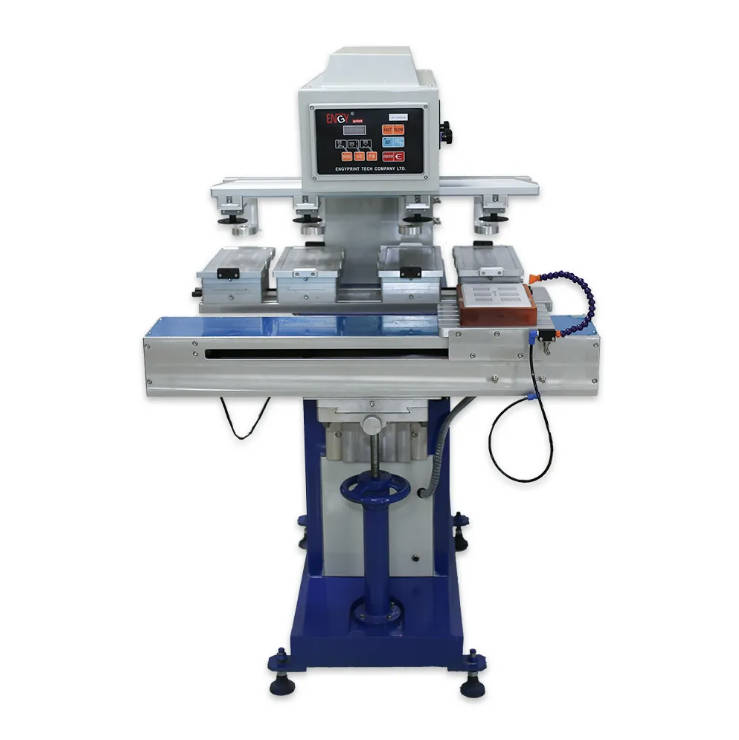Introduction
Pad printing, a versatile and efficient printing technique, is widely used in various industries, from electronics to automotive. This process allows for precise application of ink onto a wide range of substrates, including plastics, metals, and ceramics. For potential buyers of a pad printing machine, understanding the intricacies of ink adhesion is crucial. One of the key factors influencing ink adhesion is the surface tension of the substrates being printed on. This article aims to explain how surface tension affects ink adhesion and provide guidance on choosing the right pad printer for your needs.

Basics of Surface Tension
Surface tension is a physical property of liquids that describes the cohesive force at the surface of the liquid. It is measured in dynes per centimeter (dynes/cm). This force causes the surface of a liquid to contract, creating a sort of ‘skin’ on the liquid’s surface. Different materials have varying surface tensions. For instance, water has a high surface tension of approximately 72 dynes/cm, while many common plastics, such as polyethylene and polypropylene, have much lower surface tensions, often below 30 dynes/cm.
Understanding the surface tension of the substrates you intend to print on is essential because it directly impacts how well the ink will adhere to the surface.
Ink Adhesion in Pad Printing
Ink adhesion refers to the ability of the ink to stick to the substrate after it has been transferred from the pad. This is critical in ensuring the durability and quality of the printed image. Several factors affect ink adhesion, including the type of substrate, the formulation of the ink, and the conditions under which the printing is carried out.
Pad printing machines are designed to transfer ink from a cliché to a substrate via a silicone pad. The success of this transfer largely depends on how well the ink can wet and bond with the substrate’s surface. Poor adhesion can result in defects such as smudging, peeling, or fading of the print.
Relationship Between Surface Tension and Ink Adhesion
The relationship between surface tension and ink adhesion is rooted in the concept of wettability. Wettability is the ability of a liquid (in this case, ink) to maintain contact with a solid surface (the substrate). This is influenced by the surface energy of the substrate and the surface tension of the ink.
For optimal ink adhesion, the surface tension of the ink must be lower than the surface energy of the substrate. When this condition is met, the ink can spread out, or ‘wet,’ the substrate more effectively, leading to better bonding. High surface tension substrates, such as metals and glass, generally allow for good ink adhesion because the ink can wet the surface easily. Conversely, low surface tension substrates, like certain plastics, can be challenging because the ink tends to bead up rather than spread out.
Surface Tension Challenges in Pad Printing
Several challenges arise when printing on substrates with low surface tension. For instance, printing on polyethylene or polypropylene can be problematic because these materials do not naturally allow ink to adhere well. This often results in poor print quality, with issues such as smudging, peeling, or fading.
Pad printer manufacturers have developed various techniques and technologies to address these challenges. Understanding these solutions is crucial for anyone looking to purchase a pad printer, as they can significantly impact the efficiency and quality of the printing process.
Solutions and Techniques to Improve Ink Adhesion
To overcome the challenges posed by low surface tension substrates, several surface treatment methods can be employed. These methods increase the surface energy of the substrate, improving ink wettability and adhesion.
Surface Treatment Methods
- Corona Treatment: This process involves exposing the substrate to a high-voltage electrical discharge. The treatment increases the surface energy by creating polar groups on the surface, enhancing ink adhesion. Corona treatment is widely used for treating plastics before pad printing.
- Plasma Treatment: Similar to corona treatment, plasma treatment involves exposing the substrate to a plasma field. This method is highly effective for cleaning and activating the surface, making it more receptive to ink. It is particularly useful for complex or three-dimensional objects.
- Flame Treatment: This method uses a controlled flame to oxidize the surface of the substrate. The oxidation process increases the surface energy, improving ink adhesion. Flame treatment is often used for treating polyethylene and polypropylene surfaces.
Further more, for PP material, there is a special chemical liquid can do the surface treatment, it might be able to find in the ink supplier’s store.
Adhesion Promoters and Primers
In addition to surface treatments, using adhesion promoters or primers can significantly enhance ink adhesion. These materials are applied to the substrate before printing and act as a bonding layer between the substrate and the ink. They are especially useful for challenging substrates where surface treatments alone may not be sufficient.
Choosing the Right Pad Printing Machine
When selecting a pad printing machine, it is essential to consider features that address surface tension challenges. Here are some key factors to keep in mind:
Machine Flexibility
Look for a pad printing machine that offers flexibility in terms of substrate compatibility. The machine should be able to handle a variety of substrates, including those with low surface tension. This versatility is crucial for businesses that need to print on different materials.(it is more related to the fixture)
Compatibility with Surface Treatments
Ensure that the pad printer you choose is compatible with various surface treatment methods. Some pad printing machines come with integrated surface treatment units, such as corona or plasma systems, which can simplify the printing process and improve efficiency.
Advanced Technologies
Modern pad printers incorporate advanced technologies to enhance print quality and adhesion. Features such as adjustable printing parameters, precise control over ink deposition, and automatic cleaning systems can make a significant difference in managing surface tension issues. Investing in a technologically advanced pad printer can lead to better results and fewer production problems.
Case Studies and Practical Examples
Understanding how companies have successfully tackled surface tension challenges can provide valuable insights for potential buyers. Here are a few real-world examples:
Case Study 1: Electronics Manufacturer
An electronics manufacturer faced issues with ink adhesion on plastic casings. By incorporating a pad printer with an integrated plasma treatment unit, they improved surface energy and achieved excellent ink adhesion. This solution not only enhanced print quality but also reduced production downtime.
Case Study 2: Automotive Parts Supplier
A supplier of automotive parts struggled with printing on polypropylene components. They implemented a combination of flame treatment and adhesion promoters, along with using a specialized ink formulation. The result was a significant improvement in print durability, meeting the stringent quality standards of the automotive industry.
Conclusion
Understanding the impact of surface tension on ink adhesion is essential for achieving successful pad printing results. By addressing surface tension challenges through appropriate surface treatments, adhesion promoters, and selecting the right pad printing machine, businesses can ensure high-quality, durable prints on a wide range of substrates. When purchasing a pad printer, consider the flexibility, compatibility with surface treatments, and advanced technologies offered by the pad printer manufacturer. With the right approach and equipment, you can overcome surface tension issues and achieve excellent printing results.





